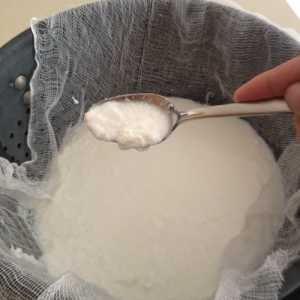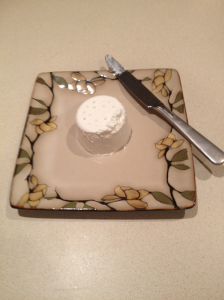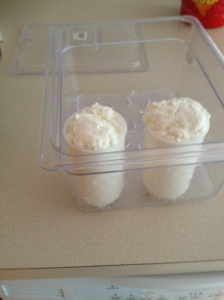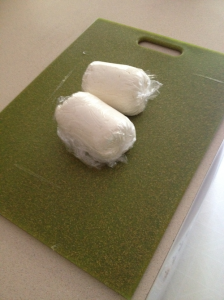With two success at cheesemaking under my virtual belt, I decided to move onto making a basic goat cheese, also known as chèvre. I began as usual, reading the recipe, ordering what I needed; in this case a new culture and molds and a draining tray.
The author recommends a specific culture for each cheese, but since I could only find the culture at one website and (it was a tiny amount for a fairly hefty price tag) I found the molds and a draining tray at another website, I opted to order a chèvre culture from the website where I ordered the other equipment to save on shipping.
The day I was making this cheese was crazy. I was also making lacto-fermented pickles, and some other items. By the time I got to the cheese, it was about 9pm when I started, So rather than thinking things through, I just followed the recipe exactly. The cheese has to sit on the stove at room temperature for 12 hours before the next step, so that’s what I did. But at 4 in the morning, I woke up, bolted awake and said to myself. “I didn’t add any rennet”.
Rennet is what makes the cheese coagulate. Cultures add the flavors that wild yeasts and bacteria used to which enables us to make a variety of cheeses rather than simply the cheese in a particular area. So I got out of bed, got the book and re-looked at the recipe. There was no rennet mentioned in the recipe at all. I got out my iPad (which was handy) and went to the book’s website to see if there were corrections (errata). There were no corrections to the recipe.
I then peeked at the actual stuff I was making itself. The milk had definitely thickened due to the culture, but it wasn’t even close to making curds. So I added some, probably not enough, but I was so freaked out I didn’t know what else to do. I really didn’t want to just throw a gallon of goat milk away (that stuff is about 30% more costly than cow milk). So I added a small amount of rennet and left it for the remaining time, about 5 hours.

Very watery looking curds
When I came back to it, it had coagulated a bit, but didn’t look anything like the cottage cheese I had made a few weeks ago. Then again it was my first time I was working with goat’s milk. Perhaps that’s just the way it was?
I decided to continue with the process and see what I got. For chèvre, the process is to drain it in cheesecloth for 5 minutes and then to ladle it into molds for another 12 to firm it up. So that’s what I did.

The output from my first attempt at chèvre
After all of that time, and energy, I actually had a cheese. The problem was that I’m supposed to get about a pound of cheese from 1 gallon of milk. I got about 4 ounces instead. So while the flavor was good, it didn’t feel like a chèvre and I determined to do it again.
During the two weeks before I could make it again, I emailed the author of the book, who informed me that the culture she had recommended had its own rennet in it. Unfortunately, she didn’t mention that in the book anywhere that I could find. She did tell me the proper amount of rennet to use in the recipe if I wasn’t going to be using her recommended culture.
So I tried it again, this time adding a proper amount of rennet at the proper time. Once I got through the 12 hour culturing process, I got this:

Proper Curds this time!
An actual sold mass of curds surrounded by whey. These definitely looked closer to the curds I got with the cottage cheese. I scooped the curds into cheesecloth to drain them for 5 minutes.

Draining the curds
Once they were drained, I salted the curds and ladled them into the draining molds. This time, instead of filling up half of one mold, I filled two molds past the top.

Two molds filled past the top with chèvre curds
This was more like it. This was the amount of chèvre I was supposed to be making. After draining for 12 hours I got two rounds of chèvre totaling about 17 ounces. Just over a pound

The finished chèvre
Chèvre is a fresh cheese that needs to be used up within about a week. Even with this quantity, I had no problems using it up. Its delicious and will definitely be on my must make list.
Related articles


